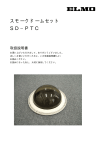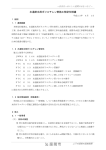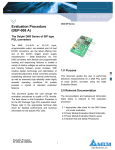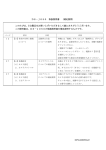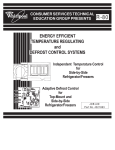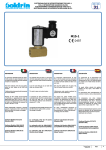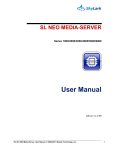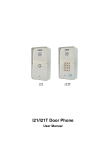Download BODY SHOP ADMINISTRATION MANUAL FOR CERTIFIED EV
Transcript
Draft as of Aug. 19th,2010 Update as of Sep. 21st,2010 Final Version as of Oct.15th,2010 Revised Version as of Nov.12nd,2010 BODY SHOP ADMINISTRATION MANUAL FOR CERTIFIED EV DEALER Global Aftersales Planning Dept. Nissan Motor Co., Ltd. Forewo rd This manual describes the body and paint repair processes that dealers should follow as they are related to the Nissan Leaf Electric Vehicle. This vehicle is equipped with a high-voltage Li-ion Battery pack. Improper repair procedures may result in serious consequences such as electrocution. Please read this manual before beginning any body or paint repair procedures on the LEAF Electric Vehicle. Follow the instructions to ensure a safe repair. IMPORTANT INFORMATION FOR SAFETY DESCRIPTION You will see various symbols in this manual. They are used in the following ways: This is used to indicate the presence of a hazard that will cause death. To avoid or reduce the risk, the procedures must be followed precisely. This is used to indicate the presence of a hazard that could cause death or serious personal injury. To avoid or reduce the risk, the procedures must be followed precisely. This is used to indicate the presence of a hazard that could cause minor or moderate personal injury or damage to your vehicle. To avoid or reduce the risk, the procedures must be followed carefully. Please note that there may be differences between the information provided in this manual and the actual vehicle you are working on due to specification changes. All information,specifications and illustrations in this manual are those in effect at the time of printing. NISSAN reserves the right to change specifications or design at any time without notice. Table of Contents 1.Summary of Body Repair Work Flow 2.High-Voltage Parts Requiring Removal 3.Business Consignment to Outsourced Body Shops 4.Work Flow from Certified EV Dealer to Body Shop 4-1 Customer Reception and Vehicle Processing 4-2 Identifying Related Parts 4-3 Removal of Related Parts 4-4 Arranging for Transport 4-5 Preparation of Repair Estimate 4-6 Approval to Start Repairs from Insurance Company (Customer) 4-7 Feedback to Estimate 4-8 Ordering Parts 4-9 Repair of Damaged Vehicles 4-10 Arranging for Vehicle Transport 4-11 Finalize Repair Cost 4-12 Installation of Related Parts and Final Inspection 4-13 Invoice to Customer 4-14 Vehicle Delivery to Customer 5.Process Procedure Details for Body Repair and Painting 6.Precautions for Body Repair and Painting 7. In the Event of an Accident 7-1 Protection for Electric Shock 7-2 In the Event of Li-ion Battery Pack Damage 1. Summary of Body Repair Work Flow The EV vehicle, should only be delivered to a body shop after removing Li-ion battery pack, high-voltage parts and any related parts that may be an obstacle to the body repair and painting process. Return of the vehicle for installation of both Li-ion battery pack and high-voltage parts Certified Customer EV Dealer’s Is it the minor damage※1 workshop Removal of both Li-ion battery pack and highvoltage parts※2 No ? Body shop (Body Repair and ainting) Yes Body shop (Body Repair and Painting) ※2 : EV Dealer’s workshop : Body shop ※1. The minor damage ・There is only a scratch or unevenness on an outer panel(fender,door,etc) or bumper ※2. The temperature of paint booth (Refer to 6.Precautions for Body Repair and Painting for details.) ・If the paint booth temperature is more than 140°F(60℃), have the Li-ion Battery removed from the vehicle by the certified EV dealer and then deliver the vehicle to body shop. ※3.High-voltage parts except for Li-ion battery pack ・Traction Motor Inverter ・DC/DC J/B ・Traction Motor ・Electric Compressor ・PTC Elements Heater ・On Board Charger・Service plug ・Charge port ・Front Side Li-ion Battery High Voltage Harness Connector 2.High-Voltage Parts Requiring Removal High-voltage parts requiring removal when replacing welded panel components-1 (Front body) Refer to the following table. For further details, refer to BRM section of Electronic Service Manual (ESM). Layout of high-voltage parts On Board Service plug Charger DC/DC J/B※ Traction Motor Inverter Charge port Li-ion Battery Electric PTC Elements Heater Compressor Traction Motor NO Major welding operation items ※This component include a DC/DC converter and high voltage junction box(J/B). High-votage parts requiring removal 1 Radiator Core Support Li-ion Battery,Service plug,Charge port, Front Side Li-ion Battery High Voltage Harness Connector 2 Hood ledge partial replacement 3 Hood ledge complete replacement Li-ion Battery,Service plug, Charge port, Front Side Li-ion Battery High Voltage Harness Connector,PTC Elements Heater, Traction Motor, Electric Compressor, Traction Motor Inverter, DC/DC J/B 4 Front side member partial replacement Li-ion Battery,Service plug,Charge port, Front Side Li-ion Battery High Voltage Harness Connector 5 Front side member complete replacement Li-ion Battery,Service plug, Charge port, Front Side Li-ion Battery High Voltage Harness Connector,PTC Elements Heater, Traction Motor, Electric Compressor, Traction Motor Inverter, DC/DC J/B 5 3 4 2 2 1 2 2. High-Voltage Parts Requiring Removal High-voltage parts requiring removal when replacing welded panel components-2 (Side body, Under body) Refer to the following table. For further details, refer to BRM section of Electronic Service Manual (ESM). NO Major welding operation items 6 Outer Front Pillar partial replacement 7 Outer Center pillar partial replacement 8 Outer Sill partial replacement 9 Rear Fender partial replacement 10 Rear panel replacement 11 Rear Side Member Extension replacement 12 Rear Floor Rear replacement High-voltage parts requiring removal Li-ion Battery, Service plug, Front Side Li-ion Battery High Voltage Harness Connector Li-ion Battery,Service plug,On Board Charger,Front Side Li-ion Battery High Voltage Harness Connector 9 10 12 7 6 11 11 8 3.Business Consignment to Outsourced Body Shops Certified EV dealers that do not own an in-house Body & Paint shop, it will be necessary to negotiate and sign a business consignment agreement with an outsourced body shop. In the case of a certified EV dealer that does not perform body & paint work in-house, business consignment to an outsourced body shop is necessary. Customers must be informed that some repair work will be performed by someone other than the dealership. Please keep the following points in mind when servicing customers so as to prevent any confusion. Points to keep in mind when consigning business to an outsourced body shop 1 Reception Even if the repair is consigned, customer reception and processing should be handled at the certified EV dealer. In some cases , customers may drive the vehicle to the outsourced body shop if it is more convenient for the customer. 2 Transport between the certified EV dealer and an outsourced body shop Because related components (including high-voltage parts) ※are removed by a certified EV dealer, a transportation fee is added to the customer’s account. (Refer to 3-4 and 3-10 for details.) Completion inspection After being repaired at an outsourced body shop, vehicles will be returned to the certified EV dealer where the high-voltage parts are to be reinstalled and a final quality inspection using CONSULT-Ⅲplus. 3 ※: Related parts are parts located in surrounding area of vehicle damage and include high-voltage parts that may cause an obstacle for body repair and painting. 3.Business Consignment to Outsourced Body Shops z When the business consignment contract is finalized, the certified EV dealer shall make an offer to the outsourced body shop. z The contents of the business consignment contract should be prepared referencing the following items. • Consigning party and consigned party • Consignment fee • Term of contract • Delivery and receipt of vehicles • Dealing with accident during the term of consignment • Re-repair • Confidentiality、etc Customer Removal and installation of related parts※ and final inspection B&P entry A certified EV dealer that does not own an in-house body shop. Request for body repair and painting Outsourced body shop Carrying in/out vehicle Scope of business ※: Related parts are parts located in surrounding area of vehicle damage and include high-voltage parts that may cause an obstacle for body repair and painting. 4.Work Flow from a Certified EV Dealer to Body Shop z The following are the assignments and workflow from receipt of a vehicle that has been in an accident to vehicle delivery to the customer after repair completion. z Detailed work processes are described from the next page forward. Certified EV dealer Body Shop (1) Customer reception and vehicle processing Service advisor(SA) or Sales person (2) Identifying related parts* (3) Removal of related parts* (4) Arranging for transport(EV dealer~Body shop) Estimator (5) Preparation of estimate sheet (6)Approval to start repair from insurance company (customer) (7) Estimate feedback (8) Ordering parts (9) Vehicle repair (10) Arranging for transport (Body shop~EV dealer) (11) Finalize repair cost (12) Installation of related parts* and final inspection (13) Invoice to customer (14) Vehicle delivery to customer *: Related parts are parts located in surrounding area of vehicle damage and include highvoltage parts that may cause an obstacle for body repair and painting. 4-1Customer Reception and Vehicle Processing Certified EV dealer Certified EV dealer Body shop z When a customer requests repairs to be done to a car that has been in an accident, the Service Advisor (SA) or a sales person will process the request. z If the vehicle is insured, check if the insurance company has been informed. z When the vehicle arrives, perform a walk-around check in the presence of the customer. z Certified EV dealer will consign the repair to the body shop. Note: Some customers may want to repair just small scratches on the bumper,etc.In such a case, where to consign the repair work may be determined by the Certified EV dealer in consultation with the customer. z Inform the customer that repairs by the body shop entail a transportation fee. < Regarding the transport fee> To ensure the safety of body shop personnel, EV Li-ion Battery and High-Voltage parts located near the damaged portion of the vehicle shall be removed and installed by a certified EV dealer. Certified EV dealers have the facilities, equipment and exclusively trained technicians to safely service your vehicle. Failure to have a certified EV technician remove or install EV Li-ion Battery and High-Voltage parts could result in serious personal injury or death. Transportation fees are necessary to move the vehicle between the certified EV dealer and body shop. These fees are invoiced to the insurance company or the customer. 4-2 Identifying Related Parts Identifying related parts Certified EV dealer Body shop z Identify parts (including high-voltage parts) that may cause an obstacle for body repair and painting by referring to the BRM section of Electronic Service Manual (ESM) . z Check related parts* for damage, and determine whether or not the related part is reusable. * Judgment standard: No damage, no concaves, no dents, and no cracks. 4-3 Removal of related parts Removal of related parts Certified EV dealer Body shop z Remove related parts including high-voltage parts and retain parts at the service department of the certified EV dealer. z For removal procedures of related parts, refer to the following manual. Welding panel parts: BRM section of ESM Exterior parts, interior parts, high-voltage parts, glass parts: ESM ● The following precautions are for the safe storage of removed high-voltage parts. To prevent electric shock, immediately apply insulation protection using insulation tape on removed high-voltage connector, terminals and any damaged portion or parts. Failure to apply insulation protection to highvoltage connectors, terminals or damage parts could result in serious personal injury or death. Refer to ESM for details. 4-4 Arranging for Transport Arranging for Transport (Certified EV dealer~Body shop) Certified EV dealer Body shop < Precautions for transporting a vehicle > z To prevent further vehicle damage caused by electricity generation by the vehicles motor, always transport the vehicle with front wheels (drive wheels) or all 4 wheels raised as illustrated. Towing Transport method Precautions and conditions OK Lift up 4 wheels ・Completely secure the vehicle. OK Lift up front wheels ・Always release the parking brake. See “ Parking brake manual release” described in the Owners Manual. Not OK ・Never tow with the front wheels on the ground or four wheels on the ground (forward or backward). Otherwise, induced electricity is generated by drive motor. 4-4 Arranging for Transport Arranging for Transport (Certified EV dealer~Body shop) Certified EV dealer Body shop < Precautions for towing> (1) Location of towing hook Location of towing hook attachment point (The hook is stored in the left side of the luggage room) (2) For any of the following conditions, turn the power switch to the OFF position, wear insulated gloves, disconnect service plug, and transport the vehicle using a vehicle transport vehicle. ● High-voltage parts or wiring harnesses are damaged ● Drive system, brakes, suspension or tires are damaged ● Coolant leakage is detected ● READY lamp does not turn ON when power switch is in the ON position 4-5 Preparation of Estimate Sheet Preparation of Estimate Sheet Certified EV dealer Body shop z Body shop estimator shall give an estimate for the total cost of repair. ● Include any special requests from the customer to the estimate worksheet. ● Include services provided by a certified EV dealer such as removal of related parts, identification of reusable and non-reusable parts and include them in the estimate worksheet. < Estimation sheet details > Category Repair fee of the vehicle Description Certified EV dealer Parts fee ○ Parts removal installation labor ○ ○ ○ Body repair and paint refinishing labor Transportation fee Certified EV dealer~Body shop ○ ○ Body shop~Certified EV dealer Inspection fee Inspection using CONSULT-Ⅲ plus Body shop ○ Cost to be agreed on with the insurance company Certified EV dealer Body shop Certified EV dealer (Inspection fee and removal fee of related parts*) (Transportation fee) (Body repair and painting fee and others) (Transportation fee) Agreed payment of insurance company (Inspection fee and installation fee of related parts*) *: Related parts are parts located in surrounding area of vehicle damage and include high-voltage parts that may cause an obstacle for body repair and painting. 4-6 Approval to start repairs from Insurance Company (Customer) Approval to start repairs Certified EV dealer Body shop z After preparing an estimate worksheet, the body shop should send it to the customer’s insurance company (by e-mail with a digital picture attached or fax, etc.) z In the presence of a representative of the insurance company, obtain an approval to start the repair. 4-7 Feedback to Estimate Body shop→Certified EV Dealer Certified EV dealer Body shop ●Send the estimate worksheet (description of damage, repair and repair cost) prepared by the body shop to the certified EV Dealer and explain the contents of the repair. ● After gaining the approval of the insurance company and the customer, the person in charge of parts in the body shop should order parts from the certified EV dealer. ● Explain to the certified EV dealer about repairs that are not covered by insurance ( to be borne by the customer) ■ Certified EV Dealer (SA)→Customer Certified EV dealer Body shop ● The certified EV dealer should explain to the customer about the contents of the repair, parts used, repair costs, and the substitution fee. ● Provide an explanation to the customer regarding repairs not covered by insurance ( to be borne by the customer), and gain approval for the work. Flow of estimate feedback Body Shop Certified EV dealer (SA) Customer 4-8 Ordering Parts ■ Ordering Parts Certified EV dealer Body shop z The certified EV dealer will issue an order for parts to National Sales Company (NSC) based on the request from the body shop (confirm the parts order against the estimate worksheet). ● If the promised delivery date is delayed due to back ordered parts, negotiate the schedule with the body shop and be sure to gain the customer’s consent. 4-9 The Repair of Cars Involved in an Accident Repair of an Accident Car Certified EV dealer Body shop z If additional work is required, inform the customer via the insurance company or certified EV dealer service advisor (SA) and gain the consent of both the customer and the insurance company to perform work. z In cases where the repair schedule is delayed due to additional work, inform the certified EV dealer of the scheduled completion date and gain the customer’s consent. 4-10 Arranging for transport Arranging for Transport (Body shop ~Certified EV dealer) Certified EV dealer Body shop z Transport from the body shop to the certified EV dealer should be arranged by the body shop based on the consignment contract. (For details, see 4-4 Arranging for Transport.) 4-11 Finalize repair coat Finalize Repair Cost Certified EV dealer Body shop After finalizing the repair charges for the vehicle, the body shop will charge the insurance company or certified EV dealer (in the case of self-pay repairs) for the following items based on the contents of the consignment contract. z Part expenses z Labor charge (technical fee) z Inspection fee at certified EV dealer STransport fee from certified EV dealer to the body shop (check with certified EV dealer regarding the cost) STransport fee from the body shop to certified EV dealer Note) items with S are charged if a transportation fee was incurred. 4-12 Installation of Related Parts and Final Inspection Installation of related parts Certified EV dealer Body shop z Install related parts that are removed in section 4-3. ● Damaged parts are to be replaced in accordance with service part establishment. Final inspection Certified EV dealer Body shop z The certified EV dealer performs final inspection using CONSULT-Ⅲ plus and confirms the repair of the vehicle is complete. 4-13 Invoice to customer Certified EV dealer Body shop z Based on the invoice from the body shop, the certified EV dealer will create an invoice. 4-14 Vehicle Delivery to Customer Vehicle Delivery Process Certified EV dealer Body shop z Inform the customer of the delivery date of the vehicle. z When the customer comes to the store, confirm the contents of the repair in the presence of the customer on the actual vehicle. z Explain the repair contents, repair cost, maintenance contents, etc. z If any fare-paying repair※is involved, have the charge paid. ※ Maintenance charge such as inspection of Charging system, Wheel alignment adjustment, and replacement of LLC,etc. z The service advisor (SA) or sales person in charge will make a follow up telephone call about a week after the delivery. 5. Process Procedure Details for Body Repair and Painting Certified EV dealers’ work shop Customer In-house or outsourced body shop Bring the car to the EV dealer’s work shop Check if the EV system warning indicator is lit. ※1:Refer to 1. Summary of Body Repair Work Flow ※2:Stated in the BRM for each operation unit. Lit Check for malfunctions using CONSULT Ⅲ Plus and visual inspection. Identify the malfunctioning high-voltage system part. Not lit Check if there is any damage as described below. No ・There is only a scratch or unevenness on an outer panel or bumper, and there is no damage to high-voltage system parts※1. Yes Repair the minor damage at the body shop Identify the damaged part, and verify the high-voltage system part/parts that need to be removed. ※1 A:High-voltage system part/parts that require removal due to damage , as well as relevant harnesses. ・Judgment standard:No damage,no concave, no dents, and no cracks B:High-voltage system parts and relevant harnesses that are placed around the damaged area and obstruct body repair&painting.※2 (Removal is required as incidental work.) After disconnecting 12V battery negative terminal remove the Service plug.※4 After waiting 10 minutes, measure the residual voltage of the high-voltage system part to make sure that it is 5V or less. Removal of both Li-ion battery pack and related parts (include high-voltage parts)※3 Repair medium or large damage at the body shop(using frame straightening equipment) The car will be transported to the EV dealer’s workshop Installation of both Li-ion battery pack and related parts(include high-voltage parts) Install the Service plug The car will be transported to the dealer’s workshop. Final check ※3:If vehicle damage is so severe the high-voltage system components including Li-ion Battery cannot be removed unless it is drawn out by frame straightening equipment, a technician from the EV dealer will visit the body shop and assist the body shop to safely straighten the frame and remove the high-voltage system parts. Failure to have a certified EV technician remove or install EV High-Voltage parts could result in serious personal injury or death. Customer 5. Process Procedure Details for Body Repair and Painting ※4 In case of being unable to turn off the safety plug ・The floor panel located in service plug will be transformed in a large damage, and that will result in the replacement of the floor panel. <Procedure> ・Cut the transformed floor panel such as a red dotted line. ・Bend the floor panel and secure the opening to turn off the safety plug. Fixing point of Service Plug Cut Bend Bend Cut Openig 6. Precautions for Body Repair and Painting To ensure the safety of body shop personnel, EV Li-ion battery pack and HighVoltage parts located near the damaged portion of the vehicle shall be removed and installed by a certified EV dealer. Certified EV dealers have the facilities, equipment and exclusively trained technicians to safely service your vehicle. As a responsibility of the certified EV dealer, please ask body shop to observe the following items. ● Removal and installation of high-voltage parts(including Li-ion battery pack) and related harness Never allow the removal and installation of high-voltage parts(including Li-ion battery pack) or related harnesses to be performed by body shop technicians. If removal and installation of high-voltage parts and harnesses is necessary to support the body repair, always have body shop contact certified EV dealer so that technicians of certified EV dealer can be dispatched to body shop to perform component removal and installation. Failure to have a certified EV technician remove or install EV High-Voltage parts could result in serious personal injury or death. ● Temperature control of painting booth When a paint booth is used at the body shop, to prevent Li-ion Battery deterioration, ensure the paint booth temperature is controlled to 140˚F (60℃) or less when measured at the vehicle’s outer sill (See A below). If the paint booth temperature is more than 140˚F (60℃), have the Li-ion Battery removed from the vehicle by the certified EV dealer and then deliver the vehicle to body shop. Failure to remove the Liion Battery prior to subjecting it to temperatures above 140˚F (60℃) could result in Li-ion Battery damage. Product name Wide Range Mini IR Thermometer Stock No Company name 42510A Extech Instruments Corporation Picture Recommended thermometer (example) A:Outer sill temperature measurement part (If a sill cover(resin) is included, remove the sill cover to measure the temperature.) 6. Precautions for Body Repair and Painting ● For spot welding and CO2 arc welding High-voltage parts are not connected to ground, and therefore, are not affected by spot welding or CO2 arc welding. Removal of high-voltage parts is therefore not necessary. Always wear appropriate personal protective equipment when working on or around the EV. 7. In the event of an accident ● Be sure to check the READY lamp on the combination meter, and verify that the READY indicator lamp is off and the high voltage system is stopped. ● There is a possibility of remaining high voltage in the air conditioning system by the Remote Air Conditioning System even when the READY lamp is turned OFF and the Air Conditioning Indicator is turned ON. Please ensure that the Air Conditioning Indicator lamp is turned OFF and the Air Conditioning System is inactive. ● After High Voltage System shut down, please wait for 10 minutes to complete discharging the high voltage condenser. While waiting, do not operate. ● The High Voltage System full dischage takes 10 minutes, but after 5 minutes the voltage has dropped below 60V. ● Remove the 12 Volt battery negative(-) terminal and wait for 3 minutes. Even though the 12 Volt battery negative(-) is disconnected, the Supplemental Restraint System(SRS) Airbag maintains voltage for 3 minutes. There is a possibility of sudden SRS Airbag inflation due to harness short circuit or damage and it may cause serious injuries. Refer to ESM for details. 7-1 High Voltage Precautions ● Failure to follow any of the following WARNINGS could result in serious personal injury or death. ● Because electric vehicles contain a high voltage battery, there is the risk of electric shock, electric leakage,or similar accidents if the high voltage component and vehicle are handled incorrectly. Be sure to follow the correct work procedures when performing inspection and maintenance. ● Be sure to remove the service plug in order to shut off the high voltage circuits before performing inspection or maintenance of high voltage system harnesses and parts. ● Be sure to put the removed service plug in your pocket and carry it with you so that another person does not accidentally connect it while work is in progress. ● Be sure to wear the Appropriate protective equipment consisting of gloves, shoes and glasses/face shield before beginning work on the high voltage system. ● Clearly identify the persons responsible for high voltage work and ensure that other persons do not touch the vehicle. When not working, cover high voltage parts with an insulating cover sheet or similar item to prevent other persons from contacting them. ● There is the possibility of a malfunction occuring if the vehicle is changed to READY status while the service plug is removed. Therefore do not change the vehicle to READY status unless instructed to do so in the Service Manual. 7-1 High Voltage Precautions HIGH VOLTAGE HARNESS AND EQUIPMENT IDENTIFICATION ● The colors of the high voltage harnesses and connectors are all orange. Orange “ High Voltage “ labels are applied to the Li-ion battery and other high voltage devices. Do not carelessly touch these harnesses and parts. HANDLING OF HIGH VOLTAGE HARNESS AND TERMINALS ● To prevent electric shock, immediately apply insulation protection using insulation tape on removed high-voltage connector, terminals and any damaged portion or parts. Failure to apply insulation protection to high-voltage connectors, terminals or damage parts could result in serious personal injury or death. REGULATIONS ON WORKERS WITH MEDICAL ELECTRONICS ● ● The vehicle contains parts that contain powerful magnets. If a person who is wearing a pacemaker or other medical device is close to these parts, the medical device may be affected by the magnets. Such persons must not perform work on the vehicle. If you use any medical electric devices, such as an implantable cardiac pacemaker or an implantable cariovascular defibrillator, check with the electric medical device manufacture concerning the effects that charging may have on implanted devices before starting the charge operation. If you have an implantable cardiac pacemaker or an implantable cardiovascular defibrillator, while the battery is charging. - Do not stay inside the vehicle. - Do not go inside the vehicle, for example to remove or place an item in the passenger compartment. - Do not open the trunk for example to remove or place item in the trunk. charging may affect the operation of electric medical devices and result in serious personal injury or death. 7-1 High Voltage Precautions PROHIBITED ITEMS TO CARRY DURING THE WORK ● Because this vehicle uses components that contain high voltage and powerful magnetism, do not carry any metal products which may cause short circuits, or any magnetic media( cash cards, prepaid cards, etc.) which may be damaged on your person when working. POSTING A SIGN OF “ DANGER! HIGH VOLTAGE REPAIR IN PROGRESS. DO NOT TOUCH” ● To call the attention of other workers, indicate “ High voltage Repair in progress. Do not touch !” on vehicles where work is being performed on the high voltage systems. 7-2 In the event of Li-ion Battery pack damage (1)In the event of Li-ion Battery fluid (electrolyte solution) leakage ● Always wear the appropriate Personal Protective Equipment (PPE) to wipe up electrolyte solution leakage using a dry cloth. The used cloth must be disposed in accordance with any local, state or federal requirements. ● Li-ion Battery Electrolyte Solution Characteristics: ・Clear in color ・Neutral ・Sweet odor ・Similar viscosity to water ・Skin irritant ・Eye irritant- If contact with eyes, rinse with plenty of water and see a doctor immediately. ・Highly flammable-Ensure the accident site is well ventilated. ・Electrolyte liquid or fumes that have come into contact with water vapors in the air will create an oxidized substance. This substance may irritate skin and eyes. In these cases, rinse with plenty of water and see a doctor immediately. ・Since the Li-ion battery is made up of many small sealed battery modules, electrolyte solution will not leak in large quantity. Note: Other fluids in the vehicles are the same as those in a conventional internal combustion vehicle. 7-2 In the event of Li-ion Battery pack damage (2)Vehicle Fire ● In the case of extinguishing a fire with water, large amounts of water from a fire hydrant(if possible) must be used. DO NOT extinguish fire with a small amount of water. Small amounts of water will make toxic gas produced by a chemical reaction between the Li-ion battery electrolyte and water. ● Use a fire extinguisher (Type ABC) effective for an electrical fire(fire caused by wiring harnesses, electrical components, etc.) and oil fire ( fire caused by oil,etc.) ● In case of vehicle fire, contact fire department immediately and extinguish the fire if possible. If you must walk away from the vehicle, notify an appropriate responder or a rescue person of the fact that the vehicle is an electric car and contains a high voltage system and warn all others.





























